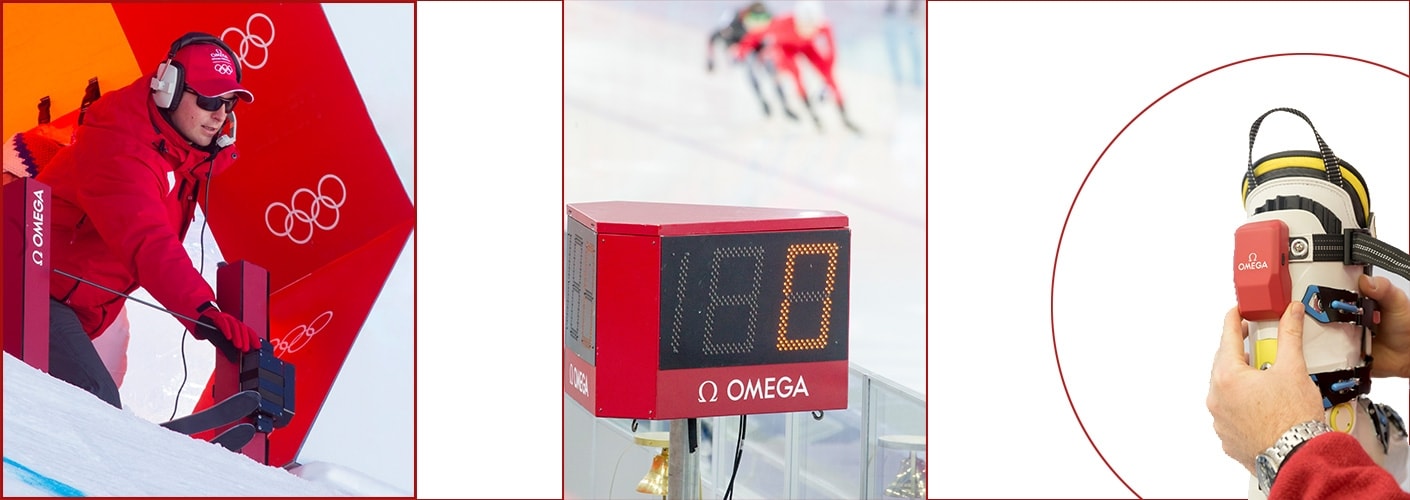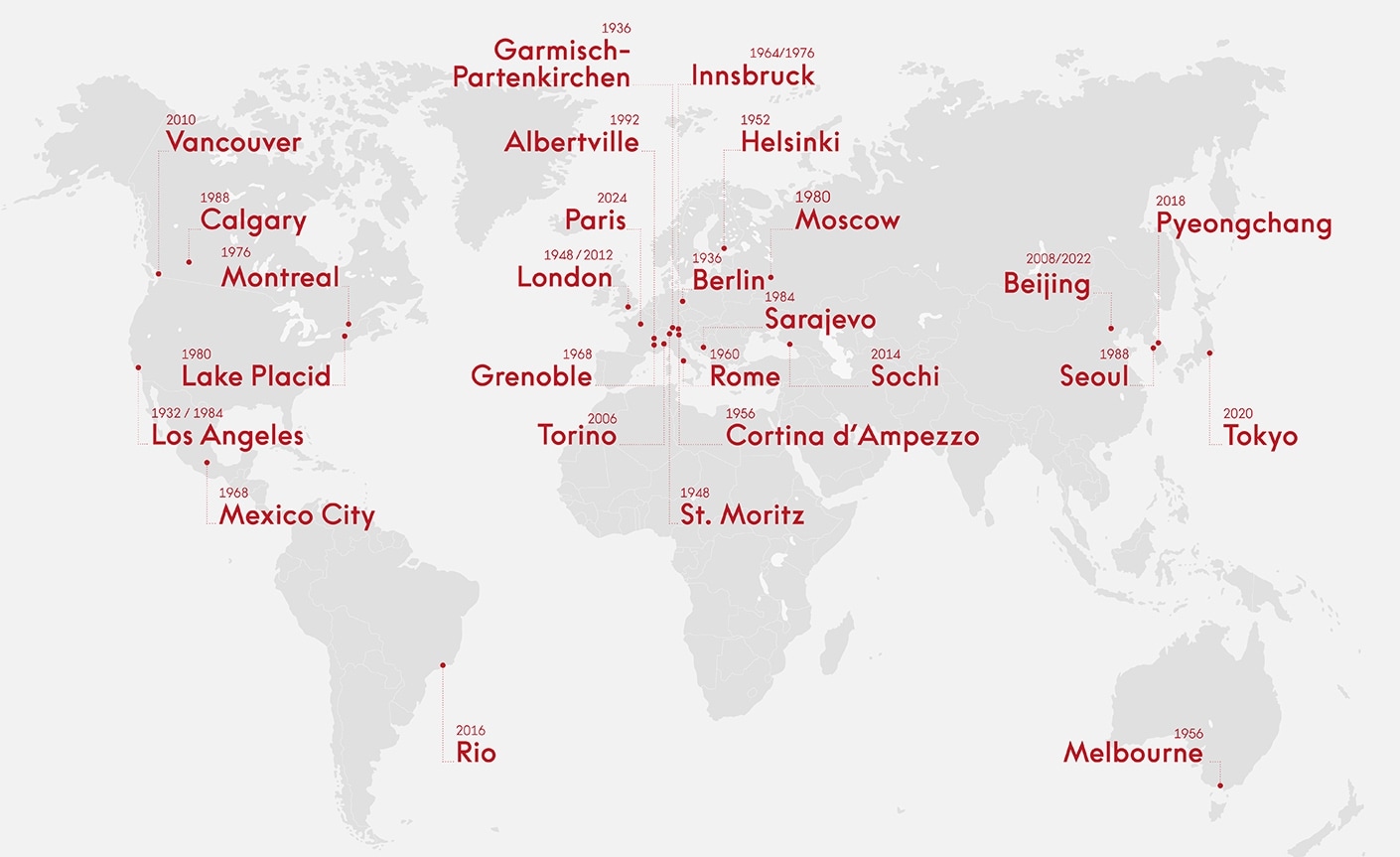Omega at the Olympic Games
As Official Timekeeper of the Olympic Games on 31 occasions since 1932, Omega has enjoyed many innovative and memorable moments during that time. These are just a few of our most defining years.
Highlights from history
Los Angeles 1932: The legacy begins
For the first time in history, a single watch company was selected as the Official Timekeeper of the Olympic Games. For its unrivalled reputation in precision awards and excellence, that prestigious title was given to Omega. It was a defining moment in the history of sports measurement that set the course for an incredible future.
The brand sent one watchmaker all the way from Bienne to Los Angeles, armed with 30 high-precision stopwatches that were accurate to the nearest 1/10th of a second.
Garmisch-Partenkirchen 1936: Timekeeping in winter
Omega’s first Olympic Winter Games were hosted at the twin villages of Garmisch-Partenkirchen. Compared to summer, the winter events posed a new set of challenges for the Swissa watchmaker, particularly in alpine skiing, where the brand had to send starting times down the mountain in the pocket of the next skier.
But Omega’s precision and dedication shone through yet again. The sun was also shining and weather conditions were perfect, setting the stage for another year of historic results and times.
London 1948: The electronic era arrives
Two of the greatest revolutions in sports timekeeping made their first summer appearance at the Olympic Games in 1948 – courtesy of Omega. This was the beginning of the “electronic era” when technology began to outperform the capabilities of the human eye.
Amongst Omega’s technologies were the first photofinish camera, pinpointing exact finish positions in races, as well as the first Photoelectric Cell, which electronically stopped the clock as the first athlete crossed the finish line. Precision had never been better!
1952 Helsinki: Rewarded for service
In appreciation of Omega’s 20 years at the Olympic Games, the brand was awarded the IOC Cross of Merit in 1952 for its “exceptional services to the world of sport.” It was a fitting tribute to the milestones achieved so far, but also reflected the continuing advancements being made. One of those advancements was the quartz-driven Omega Time Recorder.
This impressive electronic chronograph featured a high-speed printing device which enabled Omega to time events and instantly print out the results to the nearest 1/100th of a second.
Melbourne - Stockholm 1956: Swimming goes electric
Considering its watery environment, swimming has always posed a unique set of challenges for timekeepers. In 1956, however, Omega made a great leap forward by introducing the Swim Eight-O-Matic - the world’s first semiautomatic swimming timer.
The starting time was automatically triggered by the pistol while the counters were stopped at the finish by handheld electric timers. The system was better able to distinguish between swimmers who finished at virtually the same time – and signalled the beginning of other new breakthroughs in the sport.
Innsbruck 1964: Time on screen
When Omega introduced its new Omegascope technology, the Olympic Games viewing experience was changed forever. This new piece of equipment introduced the concept of “real time” sports reporting by superimposing the live times of athletes on the bottom of the screen.
Omega’s precision was now on display for millions to see, meaning that the brand had to get every measurement exactly right. Never had spectators outside a venue been so quickly informed about events.

Innsbruck 1964 - Omegascope
Mexico City 1968: Swimming changes for ever
The arrival of Omega’s swimming touchpads is considered to be one of the most important moments in timekeeping history. The pads were 90cm high by 240cm wide and two-thirds of their surface was immersed in the water. They reacted to the slightest of touches, so that when stop time with their own hands.
Now there was no disputing the precision of swimming results.
Montreal 1976: Scorboard revolutions
In Montreal, Omega’s new Video Matrix Board was able to show times, points and scores, as well as black-and-white video recordings. It was designed for multiple alphabets and beamed its information out across the Stade Olympique.
This new and exciting way to keep spectators and athletes informed of results helped to pave the way for many scoreboard updates and technical innovations into the future.
Los Angeles 1984: Catching the false start
The Olympic Games in 1984 were notable for a number of memorable athletic performances, including the four gold medals won by American Carl Lewis. Out on the track, Omega was making its own strides in timekeeping by introducing the first false start detection device.
The equipment was extremely sensitive and functioned by measuring the pressure that each runner exerted against the starting block. As the athlete launched forward, their reaction time was triggered by their physical force, enabling Omega to detect the slightest false start.

Seoul 1988: A statistical breakthrough
Seoul 1988 was the first Olympic Summer Games with computerised timekeeping. Now, instead of just measuring, allocating and printing out times, Omega was also able to digitally store vital information and statistics needed for understanding each sport.
While keeping this data secure for the future, the brand also committed itself to providing real-time information for those in the main stadium, thanks to a new video matrix board that delivered the first images and videos in colour.
Torino 2006: Athletes wearing technology
For the first time since 1992, Omega was restored to its position as Official Timekeeper of all events at the Olympic Games. In the speed skating, there was particular focus on the brand’s newest piece of technology.
For the first time at the Olympic Games, the athletes wore special transponders on their ankles. These chips were able to send and receive radio signals and allowed Omega to capture specific time measurements throughout each race.
London 2012: A millionth of a second
With an enhanced resolution of one millionth of a second, Omega’s new Quantum Timer in London was the beginning of a new generation of the brand’s timekeeping products.
The resolution was 100 times greater than previous devices and, with a maximum variation of only one second out of every ten million seconds, it was five times more accurate.
Pyeongchang 2018: Motion sensor and positioning systems
PyeongChang 2018 was the beginning of a bold new era for Omega. Through new motion sensor and positioning systems, the Official Timekeeper was able to provide continuous measurements of every athlete’s performance from start to finish.
Whether it was the live speed of a single alpine skier - or the formations of an entire ice hockey team – Omega provided in-depth information for each event as it happened. For the athletes, the new technology provided the perfect analysis of their performance, while viewers at home were given a far greater understanding of each event as it happened.

Omega's 31 Olympic Games








